Pygmalion, 1938, directed by Anthony Asquith and Leslie Howard, written by George Bernard Shaw, W. P. Lipscomb, Cecil Lewis, Ian Dalrymple, Anatole de Grunwald, and Kay Walsh, from the play by George Bernard Shaw.
Pygmalion is the story of a beautiful young woman who moves in with a pedantic jerk. And yet it was written nearly 100 years before my girlfriend and I found an apartment together. It's one of those pieces of art that most people know only through derivative works. This is not all that rare when something is adapted into a musical after the fact: raise your hand if you've read Le Fantôme de l'Opéra, or even seen the Lon Chaney version. And don't get me started on Old Possum's Book of Practical Cats. Of course, the 1938 film is already a derivative work; a film adaptation of a play. But it's a step removed from My Fair Lady, the musical, and two steps removed from My Fair Lady, the film, and since they're probably not producing the original play anywhere near you anytime soon, this is as close as you're going to get1. Besides, this is one of the rare cases where the adaptation improves on the original, at least in a few places.
Somehow or another, I assume the story has trickled into your subconscious. Professor Henry Higgins, noted linguist, bets a colleague that he can pass a flower girl off as a duchess. Higgins is played by Leslie Howard, who co-directed the film. The first time we see him, he looks like he's dressed for a noir, though he certainly doesn't have the face for it.

And Eliza Dolittle, the flower seller Higgins transforms, is played by Wendy Hiller.

The film is mostly faithful to the play, especially toward the beginning. Asquith and Howard open it up a little, but only as far as a sound stage:
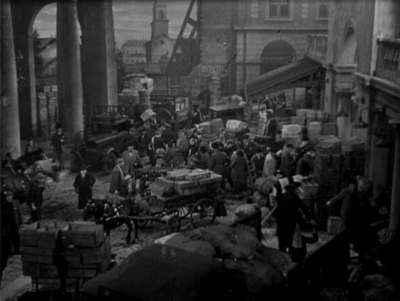
That's Covent Garden, or its sound stage equivalent, Eliza Doolittle's home turf. She overhears Higgins boast that he can turn pass her off as a duchess to fellow linguist Colonel Pickering, played by stage actor Scott Sunderland, in one of his only two film appearances.
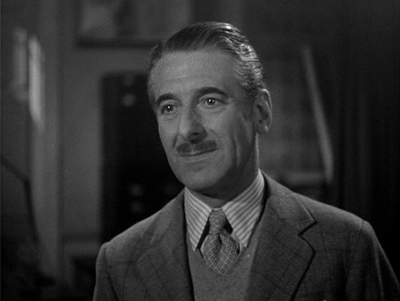
Pickering basically serves two functions in the film: being sympathetic to Eliza and giving Higgins someone to talk phonics with. As you can see, he certainly nails the first part, and the second part is just standing around smiling politely as Leslie Howard gets manic, which he does exceptionally well.
Once Eliza arrives at the Higgins household (where, conveniently enough, Pickering is staying as a guest), the film picks up an undercurrent of weirdness that isn't present on stage. In the play, Eliza is bundled off to the bathroom by Higgins's housekeeper Mrs. Pearce, she reappears a few conversations later, and that's the end of it. In the film, there's an extended "Eliza Takes The Most Terrifying Bath of Her Life" sequence, which includes Mrs. Pearce (played by Jean Cadell) getting her scrubbing brush all ready:

Eliza shrieking in horror as Mrs. Pearce scrubs her down:
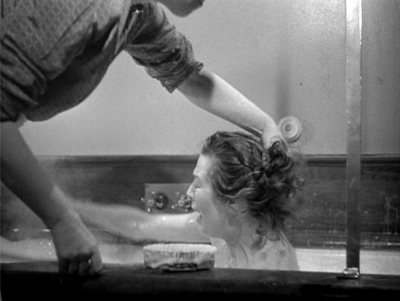
Higgins and Pickering reacting to Eliza's screaming:

And finally, more of Eliza screaming her heart out, this time in close-up:
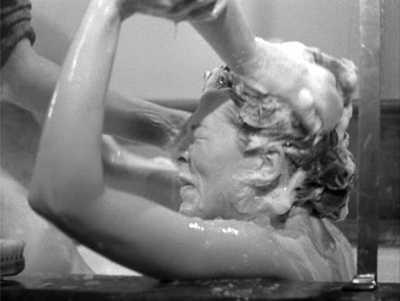
And it's a surprisingly long sequence. I was reminded of the hand-washing scenes in the Coronet educational films David Smart oversaw; I felt like I'd stumbled into a part of the movie that someone in the creative process thought was very important, but I didn't quite get it. And don't get me started on the outfit Eliza wears when Higgins begins her instruction:
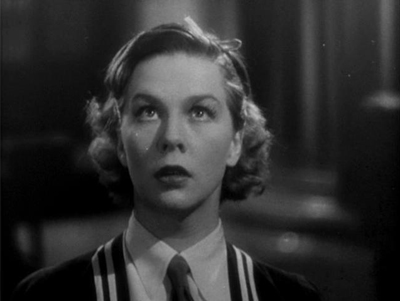
Some critical approaches to Pygmalion are best left unexplored, at least by me; suffice it to say that Howard or Asquith or Shaw seem to have some issues with control. It's not just Eliza who gets treated a little unsubtly here (and subtlety is not always a virtue). One of my favorite shots in the film is a jarring rapid push in on Leslie Howard that goes from here:

To here:
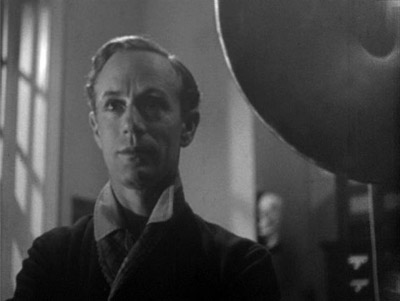
While his voice intones, "I shall make a duchess of this draggle-tailed guttersnipe." from the gramophone. He might as well be wearing a magician's hat.
The film, like the play, has two perfect scenes. The first is when Eliza's father shows up trying to extort money from Higgins. He's played by Wilfrid Lawson as the definitive disreputable scoundrel:
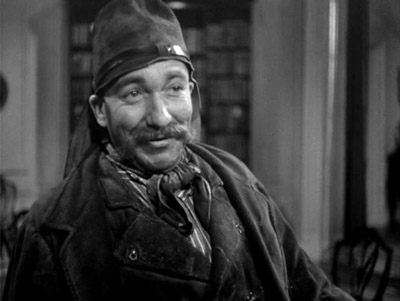
Mr. Doolittle has one of the all-time great monologues in English literature, at least if you enjoy villainy. It's not quite "smile, and murder whiles I smile", but it's twice as charming. Here's how Lawson delivers it:
I'm one of the undeserving poor... Think of what that means to a man. It means he's up against middle class morality, all the time! If there's anything going, and I puts in for a bit of it, it's always the same story: "You're undeserving; so you can't have any." And yet my needs is as great as the most deserving widow's that ever got money out of six different charities in one week for the death of the same husband. I don't need less than a deserving man: I need more. I don't eat less hearty than he does; and I drink a lot more... I'm playing straight with you. I ain't pretending to be deserving. I'm undeserving; and I mean to go on being undeserving. I likes it.
I've always thought those lines should be a lot more famous than they seem to be. Wilfrid Lawson's performance is completely scene-stealing. In a modern adaptation, such great lines would presumably go to the star ("He's undeserving! And he means to go on being undeserving!"), so it will be interesting to see what happens to them in the adaptation currently being developed for Kiera Knightly.
The other great scene is Eliza's first attempt to pass herself off in high society, at Higgins's mother's home. Wendy Hiller gives a world-class comic performances here. Her attempt at an upper-crust accent is consistently off-key throughout, and it's a joy to watch her pace herself through the scene. At the beginning, she's constantly slipping Higgins glances of horrified confusion:
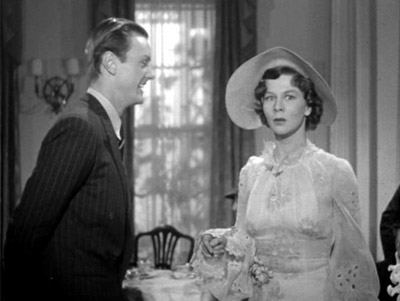
Those are funny in their own right, but they're really a lead-in for her to gradually become comfortable, then overconfident, until she's blithely telling the rest of the tea party (in that same kooky accent) that "gin was like mother's milk" to her aunt, who she believes was recently murdered.
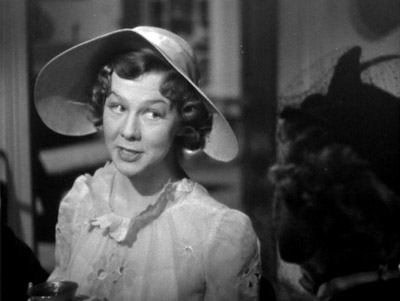
Everything comes to a head as Higgins hustles her out of there. When Freddy (the well-meaning dolt standing next to her in the still above) asks if he might accompany her home, she breezily replies, "Not bloody likely! I'm going home in a taxi!" This was, in fact, the first British film to contain the word "bloody," and, as with Snakes on a Plane, the line was part of the marketing. According to Wikipedia, there were ads reading, "Miss Pygmalion? Not ****** likely!".
There's one other notable sequence in the film, although it's less successful. For some reason, the original play does not have a scene of Eliza actually attending the ball she's been preparing for the entire play. Shaw cuts from Eliza failing to convince anyone but Freddy at Higgins's mother's house to Eliza, Pickering, and Higgins returning home after she successfully passes at a garden party, a dinner party, and the opera (all in one evening). It's such an obvious missed opportunity that I can only assume that it was left out of the play for reasons other than dramatic choice (e.g., to cut down on the number of sets for the theatrical production). But the movies aren't the movies unless they have a little wish-fulfillment, so we get to see Eliza in formal wear:

Shaw actually wrote this sequence for the film, and stocked it with one of his less-successful creations, a Hungarian linguist named Karpathy. According to the IMDB, he was based on Gabriel Pascal, who produced Pygmalian. I'm not sure how Pascal felt about the character, who Esme Percy plays as an officious know-nothing.
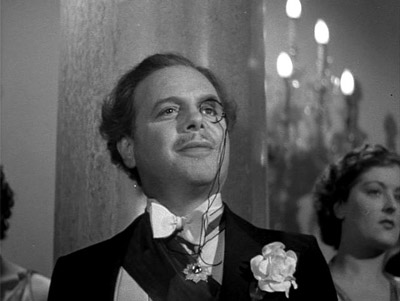
In real life, Pascal seems to have been savvier than Karpathy; for one thing, he tried to make a musical of Pygmalion years before My Fair Lady, but Shaw forbade it; he settled on making a straight film adaptation instead. Karpathy basically creates a little tension during the ball scene, as the one person who might suss out Eliza's origins and give the game up, but he's so pompous and intolerable that the threat doesn't seem real. So dramatically, this was the least successful sequence of the film. On the other hand, it has the most cinematically successful shot in the whole movie, a proto-Scorsese tracking shot that opens with Karpathy leaving his car (before we know who he is):
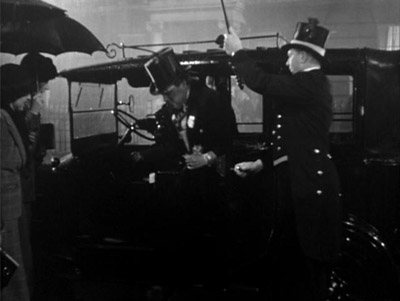
Pulls back and follows him as he enters the party:
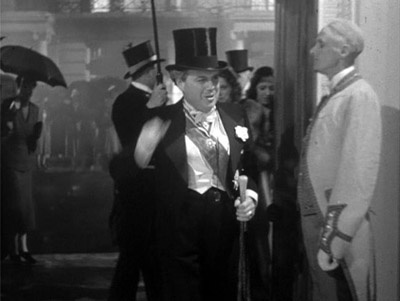
Then spins as he passes to give us a head-on shot of the dazzling entryway:
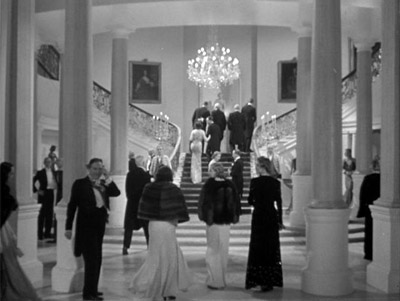
And pushes back in as Higgins and Pickering enter the frame from the left and Karpathy greets them, finally giving the audience context for what they've been watching.

It's one of the moments where the film transcends its origins on stage and gives us a perspective that's impossible in theater. There are others; you won't find any montages of Eliza learning to speak in the original play (and I'm not sure what a montage would look like on stage, obviously). When adapting a play for film, there isn't any reason to shoehorn in tricks that only work on film, unless, and this is key, they allow you to come closer to the truth of the characters or situations than you could on stage. This tracking shot is a classic example, taking us from the dark, muddy streets to the pinnacle of British society in a single turn of the camera. It's just as dazzling for the audience as it is for Eliza. And yet the camera is following Karpathy, the phoniest character in the entire film. Well, Scorsese ended the Copacabana shot with Henny Youngman telling terrible jokes, so I guess it's a tradition.
But enough about the camerawork, you're no doubt screaming; the only thing that matters in an adaptation of Pygmalion is the chemistry between Higgins and Eliza. As you probably remember, the two fall madly in love over the course of her tutelage. But you're not remembering Pygmalion, you're remembering My Fair Lady. According to his own introduction to the play, Shaw wrote Pygmalion to bring attention to the importance of phonics. I'm going to say that again: Shaw thought, or claimed he thought, he was writing about phonics. Here he is in his own words:
The English have no respect for their language, and will not teach their children to speak it. They spell it so abominably that no man can teach himself what it sounds like. It is impossible for an Englishman to open his mouth without making some other Englishman hate or despise him. German and Spanish are accessible to foreigners: English is not accessible even to Englishmen. The reformer England needs today is an energetic phonetic enthusiast: that is why I have made such a one the hero of a popular play.
In fact, Shaw was opposed to the idea that Higgins and Doolittle should fall for each other, saying in an interview, "I cannot conceive a less happy ending to the story of Pygmalion than a love affair between the middle-aged, middle-class professor, a confirmed old bachelor with a mother-fixation, and a flower girl of 18." When you put it that way, he has a point. Lerner and Loewe respectfully disagreed, of course, but in the film of Pygmalion, there's only one scene that, as Shaw put it, "give[s] a lovelorn complexion at the end to Mr. Leslie Howard: but it is too inconclusive to be worth making a fuss about." It may be the case, as Shaw has it, that Eliza would be much happier in the long run with the doltish, adoring Freddy (Shaw wrote a lengthy epilogue in which they were married). But it's also the case that Eliza and Higgins bicker and squabble like the romantic leads of a screwball comedy. So I think Shaw is a little disingenuous about the nature of Higgins and Eliza's relationship. After all, he named his play Pygmalion, and Pygmalion married his statue.
Randoms:
- Despite all the stills of sound stages above, there are a few actual exterior shots in the film. They're kind of jarring, though, because the natural light is much brighter than anything else in the film; here's Piccadilly Circus circa 1938:
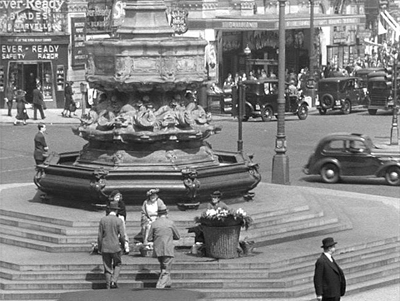
- I think we'd all prefer ads for "Ever-Ready Safety Razors" to the TDK and Sanyo signs that stand there today.
- Higgins's study is filled with vintage audio equipment of all varieties, including this strange gramophone with a cleaning brush. But the brush cleans the record right after it's hit the needle, not before:
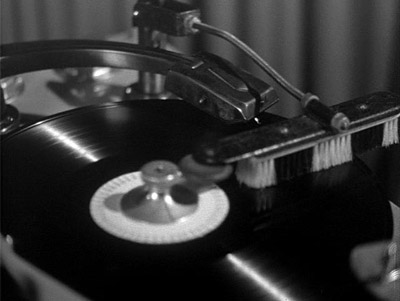
- Higgins seems to have the ability to cut his own records (he has a stack of albums of Eliza speaking), which made me think this was perhaps a recording device and the brush was to clean up the groove as it was etched. But the record here is clearly already complete. In any event, the pride of the collection is not this turntable or whatever it is, it's the hidden microphone Higgins uses to record unsuspecting guests. It's hard to imagine his guests would be too unsuspecting, however, because the microphone is hidden in a terrifyingly creepy statue that is sitting in the middle of his desk for no apparent reason:
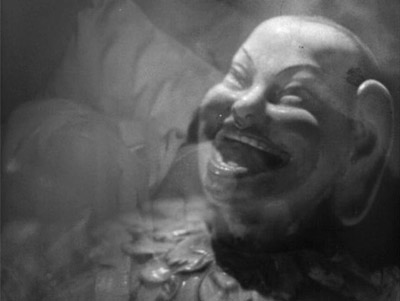
- Wondering about Higgins ability to make his own records, I wandered into an unrelated device I'd forgotten all about, the Voice-O-Graph. It was like a photo booth that produced records; you can see some shots of the machinery at the link above. Most of the visible machinery seems to be used to load and dispense the records (I'm assuming that the drum on the right was for a stack of blanks). Anyway, the point is that the recording equipment itself doesn't look all that complicated, so I guess it's possible Higgins would have something to accomplish this. If you want to see a Voice-O-Graph in action, rent Badlands.
- David Lean edited the film, and directed the montages of Higgins teaching Eliza. He basically cut them together like nightmares, complete with camera angles Carol Reed would love. I think he used some of what he learned from this film when he shot Great Expectations. They reminded me of the sequence where Pip falls ill. Which is strange, because in Great Expectations he used a long tracking shot, and in Pygmalion they're montages. But both capture a feeling of nausea; perhaps it's the camera angles.
- Leslie Howard wears glasses that are identical to the "nerd glasses" you can get at any novelty shop.

- They make him look more than a little like Dana Carvey in The Master of Disguise.

